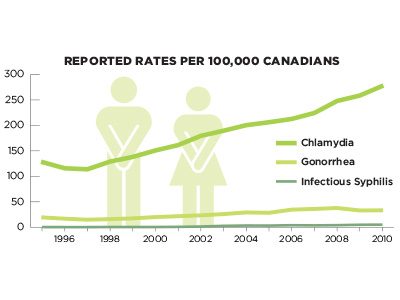
Chlamydia, gonorrhea and syphilis have a lot in common: they’re all caused by bacteria, spread by sex and nasty in their potential complications. The incidence of all three has also been rising steadily in Canada since the late 1990s. The reason for this is unclear, though it may be no coincidence that the tide turned at around the same time highly effective antiretrovirals for managing HIV/AIDS first appeared. With HIV no longer the death sentence it once was, some public-health officials posit, safe sex may seem less crucial in Canadians’ eyes.
Younger people are far more likely than older ones to contract a sexually transmitted infection (STI), possibly because of their degree of activity: according to a Statistics Canada survey, roughly one-third of sexually active 15-to-24-year-olds said they’d had more than one partner in the past year. However, the relative rate of infection is increasing most quickly among middle-aged and senior adults. With unwanted pregnancy no longer a concern, and with very few safe-sex campaigns aimed at older Canadians, it’s not surprising that condom use declines with age. To make matters worse, older folks generally received less sex education in their youth and are more reluctant to discuss sexual health with their doctors.
Chlamydia, the most common STI, accounts for 51 per cent of all the infectious diseases the federal government requires doctors to report for tracking purposes. And the actual number of cases probably outnumbers the reports by far, because the “silent disease,” as it is called, is often asymptomatic. It’s estimated that more than 50 per cent of infected men and 70 per cent of infected women are unaware of their condition.
Both chlamydia and the next-most prolific STI, gonorrhea, can be cured with antibiotics, but if left untreated, they can lead to serious troubles, including, for women, pelvic inflammatory disease-which can lead to chronic pelvic pain, ectopic pregnancy and infertility. For men, complications are less common and less severe but include orchitis, a painful swelling of the testicles.
Most people know that condoms and dental dams are the best shield against STIs, but the non-profit medical research group Mayo Clinic nevertheless recommends regular testing. In 2011, the city of Ottawa decided to simplify access to STI screening by offering printable lab forms for chlamydia and gonorrhea testing at gettestedwhynot.ca. Instead of visiting a family doctor or clinic, Ottawans can go straight to a lab with their forms to give a urine sample. This is the first program of its kind in Canada and, given the growing scope of the problem, hopefully not the last.

We’ve all been there: in an elevator, a waiting room, in line at the bank or on an airplane, surrounded by people who are, like us, deeply focused on their smartphones or, worse, struggling with the uncomfortable silence.
What’s the problem? It’s possible that we all have compromised conversational intelligence. It’s more likely that none of us initiate a conversation because it’s awkward and challenging, or we think it’s annoying and unnecessary. But the next time you find yourself among strangers, consider that small talk is worth the trouble. The experts say it’s an invaluable social ritual that results in big benefits, both personal and professional.
It’s a start
Dismissing small talk as trivial is easy, but we can’t forget that deep relationships wouldn’t even exist if it weren’t for casual conversation. Small talk is the grease for social interaction, says Bernardo Carducci, director of the Shyness Research Institute at Indiana University Southeast. “Every great romance and each big business deal begins with small talk,” he explains. “The key to successful small talk is learning how to connect with others, not just communicate with them.” According to Carducci, exploring common ground in conversation-even about something as trivial as the weather or the long lineup-works toward forging bonds between humans.
Happy is as happy does
“Big talk,” substantial conversation with greater impact on our lives, is obviously essential to our happiness. But it’s important not to overlook the value of small talk, either.
In a 2014 study, Elizabeth Dunn, associate professor of psychology at the University of British Columbia, recruited people on their way into a coffee shop. One group was asked to seek out an interaction with its barista; the other, to be as efficient in its exchanges as possible. The results showed that those who chatted briefly with their server reported significantly higher positive emotions, not to mention a considerably better coffee shop experience. “It’s not that talking to the barista is better than talking to your husband,” says Dunn. “But interactions with more peripheral members of our social network actually matter for our well-being also.”
Dunn’s findings arguably complement research released in 2013 by Andrew Steptoe of University College London. Steptoe reported that socially isolated seniors died at a higher rate than those with regular social interactions, whether through church, social clubs or contact with friends and relatives.
Making the connection
Dunn believes that people who reach out to strangers feel a significantly greater sense of belonging, a bond with others. Carducci believes nurturing this sense of community starts with small talk. “Small talk is the cornerstone of civility,” he says. “When you connect with people through conversation, you’re much less likely to mistreat them or be mistreated by them.”
A boon for business
When it comes to the working world, casual conversation is essential, too. “One of the biggest predictors of career success is verbal fluency,” says Carducci. Small talk should be viewed as the warm-up that conveys key information about you, like goodwill, trustworthiness and a willingness to co-operate.
These are the things that help seal the deal, according to Debra Fine, author of The Fine Art of Small Talk, a can’t-miss for business people. “You can negotiate a contract, make a presentation, sell a widget or promote your services, but unless you integrate small talk, you will not develop a business friendship,” she explains. “All things being equal, people do business with their friends.”

Thousands of white birds chirping everywhere around me, the salty wind of the St. Lawrence River on my face, the sound of the waves and the warmth of the sun on my skin: I can still remember every sensation from my first visit to Bonaventure Island 12 years ago. At six years old, I might not have realized it at the time, but I had just been bitten by the outdoor bug.
Those birds, with their dark wing tips and delicate yellow faces, were northern gannets; the ones I saw were part of the largest and most accessible colony in the world. More than 120,000 northern gannets live on this enchanting island, which is part of Île-Bonaventure-et-du-Rocher-Percé National Park. This amazing spot is just one of the wonderful parks in the province of Quebec. While Alberta and British Colombia often spring to mind when we think of Canada’s national parks, Quebec also offers us beautiful scenery, especially during winter.
One beautiful October day during the school break, my friends and I went on our first road trip. Our destination: Grands-Jardins National Park near Charlevoix. Climbing the hills along a bumpy road in an old yellow Beetle, we peered out the windows at the trees ablaze with fall colours, from dark red to golden yellow. It felt as if we were in another world; I still get goosebumps when I think about it. The three-day trip was short, but it included a wonderful hike at the craggy Mont-du-Lac-des-Cygnes and camping in the mountains. The park’s trails offer several types of vegetation, including subarctic taiga, rugged tundra, and mountain and boreal forests. Visitors can also go canoeing, fishing and kayaking.
While it’s tempting to stay home, snuggle in blankets and watch movies during Quebec’s cold winters, there’s plenty to do outdoors. Most national parks, including Grands-Jardins and Jacques-Cartier, stay open and offer cross-country skiing, snowshoeing and winter hiking, with trails designed for all levels. Since there’s more snowfall in those regions, you are literally surrounded by a white paradise; there’s no better way to relax and escape the stress of the city. Some national parks, such as Mont-Orford, even feature magical nighttime snowshoeing expeditions by torchlight. Each park has something different to offer, from tobogganing to ice fishing, and you’ll never get bored exploring these lesser-known Canadian gems.
Monts-Valin National Park in Saguenay-Lac-Saint-Jean is one of my favourite destinations because of its strange wintertime phenomena: ghosts and mummies. These “ghosts” are caused by strong precipitation in January and February that accumulates on trees and gives them funny white shapes resembling phantoms. “Mummies” are created when clouds hang low over the mountain summits and leave tiny droplets of water on the trees, which then freeze and look like frosty mummies.
These whimsical ice creatures are located in the park’s Vallée des Fantômes (Valley of Ghosts) and the Contrée des Momies (Land of the Mummies), which are accessible by a 45-minute ride aboard the Phantom Express, a snowcat minibus. The expedition includes a snowshoeing trek among the bewitching ghosts along a moderate three-kilometre trail. The trail also leads to Pic Dubuc; at an altitude of 984 metres, the spot offers incredible panoramic views. You can add to the experience, as I did, by spending a night in the park in one of the rustic rental cabins. There are many other activities as well, such as Hok skiing, a new sport that combines snowshoeing and cross-country skiing.
I could go on and on about all the amazing parks in Quebec, but instead, I hope you’ll discover their beauty and wonders in person. Who knows: You might get bitten by the outdoor bug, just like I was!
 I have recently been seeing a therapist to help with the health anxieties that have been plaguing me ever since my heart attack. The therapist is a Cognitive Behaviourist, and she has me working from a book where I recount the times when my mood took a turn for the worse, which we later discuss in person. These are my most recent entries:
I have recently been seeing a therapist to help with the health anxieties that have been plaguing me ever since my heart attack. The therapist is a Cognitive Behaviourist, and she has me working from a book where I recount the times when my mood took a turn for the worse, which we later discuss in person. These are my most recent entries:
THE SITUATION
Trying to broaden my horizons, I decided to listen to some award-winning throat singing. The music scared me and made me very anxious, which brought on a panic attack. As I hyperventilated, rocking back and forth, the dog thought I wanted to play and began to bark hysterically.
YOUR MOODS (rate each mood 0-100%)
Scared: 120%
Frustrated: 90%
Uncultured: 100%
YOUR THOUGHTS (highlight the HOT thought)
Throat singing sounds like an Ayahuasca hallucination.
It is demonic.
The Amityville Horror.
Is there a ghost in the apartment?
HOT THOUGHT: WAS THERE EVER A MURDER IN THIS APARTMENT?
The bedroom is always cold. Maybe the murder took place in the bedroom?
The Shining.
I can’t breathe.
I am going to die.
Will the dog eat me when I die?
How many days/hours will pass before the dog begins to eat me?
THE SITUATION
I took a Buzzfeed quiz on Facebook and it said the city I should actually live in is Portland, which was stupid and insulting.
YOUR MOODS
Anger: 100%
Bitterness: 110%
Confusion: 90%
YOUR THOUGHTS
I don’t even do yoga.
I hate hippies, plaid and Tonya Harding.
The city I should actually live in is New York.
BuzzFeed are a bunch of morons.
HOT THOUGHT: I SHOULD SUE BUZZFEED.
And when I win, move to New York.
Although I am curious about Bigfoot, and he lives near Portland.
Maybe Buzzfeed knows something I don’t.
Feeling insecure and judged.
And a little cold. Damn blood thinners.
THE SITUATION
I watched a video on global warming and then felt hot and panicky. I took my temperature and it was fine, so I took it again and it was still fine. Then I thought the thermometer must be broken and I was probably experiencing the onset of a fatal heart attack.
YOUR MOODS
Abject Terror: 200%
Anger at Big Oil and Thermometer-Making Companies: 120%
Despair: 90%
Regret: 140%
THOUGHTS
At least I’ll be spared dying of a catastrophic flood or something.
I hope the heart attack is quick and painless.
I wonder if Anthony would fly back from Africa for my funeral?
Probably not.
HOT THOUGHT: ANTHONY IS FULL OF HIMSELF.
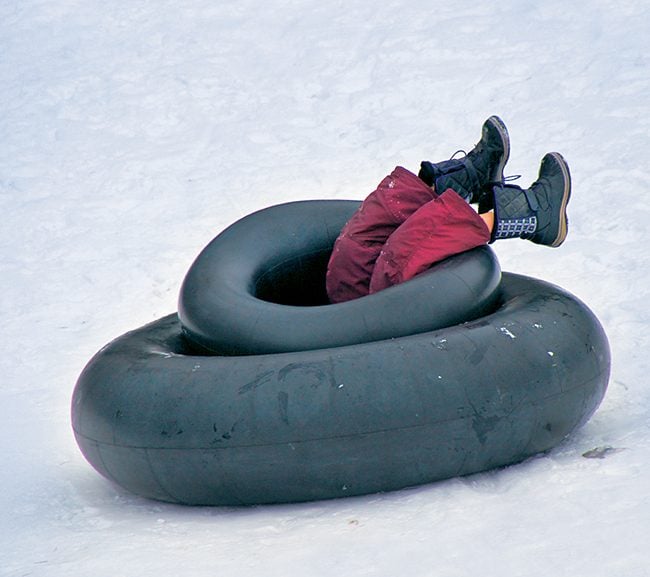
Sharon Smith of Chatham, Ont., writes, “While sledding and tubing with the family at the nearby C.M. Wilson Conservation Area, the kids loved the double-decker tubes-especially dropping through them at the bottom of the hill. Those are our daughter Cindy’s dangling feet!”
Send in your funny one-liners through the comments below or here (please identify it is an entry for Caption Corner)!
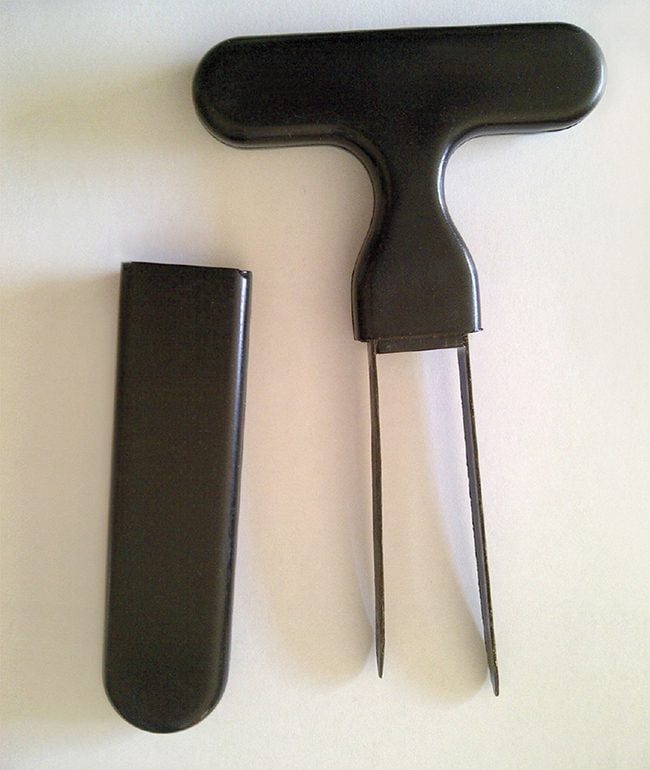
Sharon Smith of Saskatoon writes, “We found this item while preparing for a garage sale. It is a T-shaped plastic handle with two flat metal prongs and a plastic cover. I’d love to find out what it was used for!” Can anyone help Sharon solve this mystery?
Submit your answers in the comments below or here (please identify it is an entry for What Is It).

The soulmate. It’s an ancient Greek ideal that survives to this day as a fixture of Harlequin romance novels and movies starring Rachel McAdams. That predestined better half is out there (hopefully with a charming smile and eyes that sparkle like a glass of Moët & Chandon). Once found, he or she will bring eternal bliss.
The potential benefits of such a vision are understandably appealing. Believing your partner was made just for you reinforces the positive aspects of your relationship and conveniently assigns some of the relationship heavy lifting to fate. Plus, who can deny the allure of “happily ever after”?
But don’t leap into a long-term commitment simply because someone makes your heart beat with unusual gusto. Recent research, co-authored by Spike W.S. Lee, an assistant marketing professor at the University of Toronto’s Rotman School of Management, suggests that the idea of a soulmate might be the wrong way to frame a relationship. In fact, it may actually be detrimental to long-term contentment.
For the study, participants had to choose between phrases and images that indicated whether they felt that love was a search for The One or a lifelong, compromise-filled journey. Lee found that the soulmate group had significantly more negative thoughts when they reflected on conflicts in their relationships than the love-is-a-journey group. “People who view themselves as soulmates tend to be less satisfied when they think of the conflicts in their relationships,” he explains. “It’s inevitable. In the soulmate frame, conflicts are bad. People think, Well, maybe we’re not the perfect fit.”
Sue Johnson, an Ottawa-based psychologist, doesn’t believe in the idea of a perfect fit. “Whoever came up with the idea should be boiled in oil,” she jokes. In her 2013 book Love Sense, she takes a scientific approach to explain the benefits of close, long-term relationships. For example, she points to a study that performed fMRI scans on the brains of happily coupled women and notes that even when facing an imminent threat, the subjects barely had a stress reaction as long as they were holding the hands of their loved ones. Women who were unhappily coupled saw a spike in their stress levels, hand holding or not.
But arriving at a strong place of comfort and trust takes effort, not just the “magic” of finding a soulmate. Through communication, collaboration and constructive conflict resolution, you can build and sustain happy and fulfilling relationships despite not being custom-built for each other from the outset. Which no one is.
One of the key components is responding to vulnerability. It’s essential to have the courage to discuss your inner fears and hurt feelings and deep longings with a partner. “Freud said we are never so vulnerable as when we are in love,” says Johnson. But opening up can make us feel threatened or afraid or weak, and there’s always the risk the other person won’t respond well, which is why wishful thinking takes hold and often wins out. It’s simply easier (if not lazier).
Gary Direnfeld agrees that strong, lasting bonds don’t just appear miraculously. As a social worker and the former host of Slice’s marriage-counselling show, Newlywed Nearly Dead, he has seen the inside of many tortured relationships. He also dismisses the idea of a soulmate as “a very Hollywood notion and not very realistic.”
Instead, you can build the right relationship through trial, error and persistence. The hard part shouldn’t be the exhaustive search for Mr. or Ms. Right (all those hours on Plenty of Fish notwithstanding); it’s the feeling and dealing through everything that comes after that’s harder. It’s more of a slog but, in the end, more rewarding. “I advise people to date a lot, to really get to know each other before cohabiting,” he says. That’s because when a couple first meet, “there is an infatuation stage, and everyone is on their best behaviour.” But it’s important to get past that, to a point where stress becomes a factor and different conflicts arise, to see how you each react, and to start seeing how and if a true partnership can develop.
Because, ultimately, it isn’t the couples who had the most movie-worthy courtships that have long, happy unions. It’s the couples who consistently try to see each other’s viewpoints, responsively listen to each other and maintain a mutual respect that are going to last. And for people who can achieve that, as Johnson puts it, “that’s when the real magic happens.”

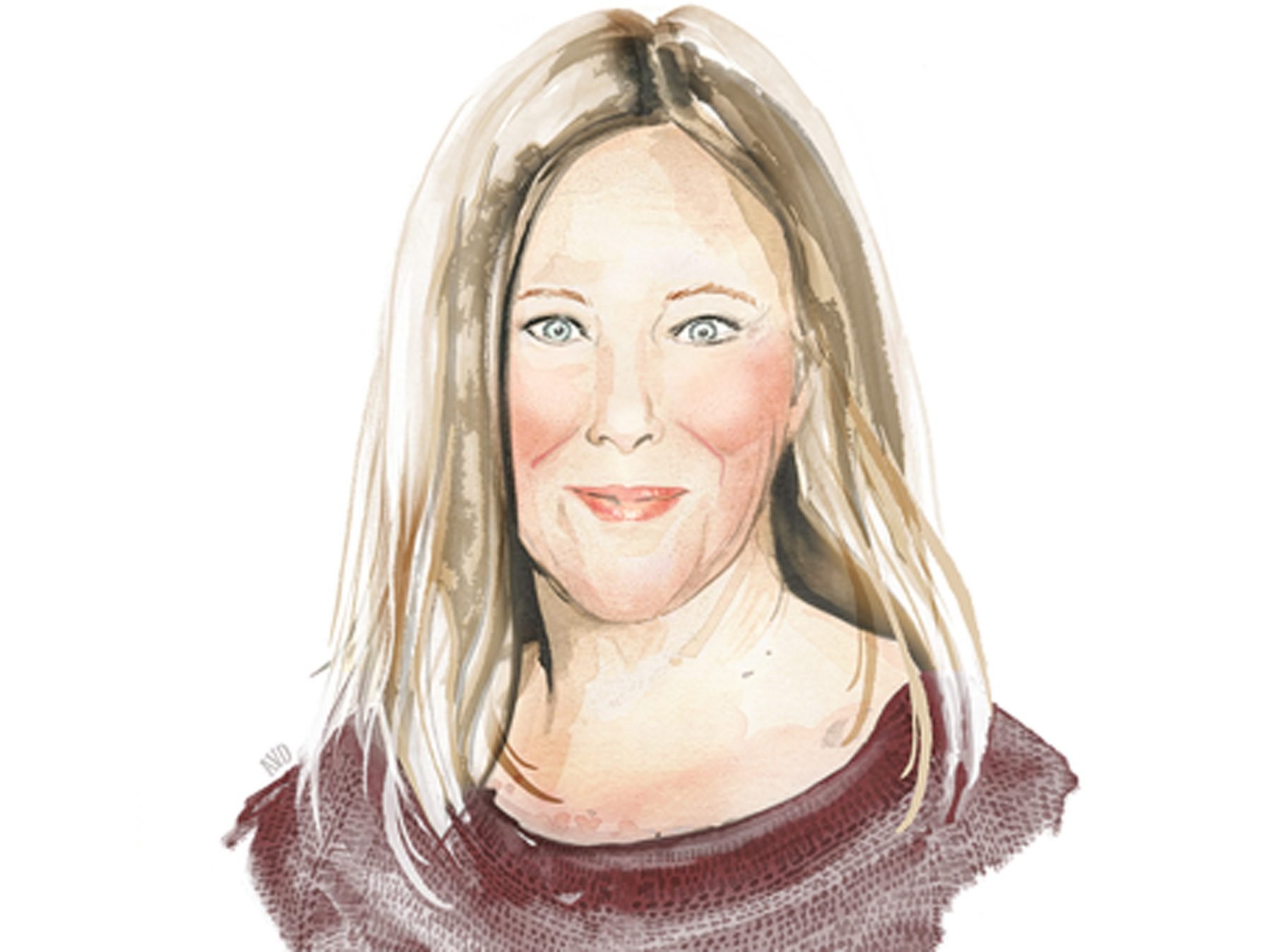 Your new show, Schitt’s Creek, is being positioned as the great hope of Canadian comedy-and the CBC. No pressure, right?
Your new show, Schitt’s Creek, is being positioned as the great hope of Canadian comedy-and the CBC. No pressure, right?
I know! When people start to talk that way, I just go somewhere else. It doesn’t mean anything. Most of the work I’ve done, nobody knew or cared about. That was the case with SCTV-we were just doing it for ourselves.
SCTV was part of a golden era. Why do you think Canada has since struggled to create iconic, mainstream comedies?
I’m happy people think so highly of SCTV now, but that wasn’t how it felt at the time. We would go to the ACTRA Awards, and Royal Canadian Air Farce would win. It’s easy to romanticize something from the past. There has been a lot of funny stuff on Canadian television since then: Kids in the Hall, Trailer Park Boys, Russell Peters.
On Schitt’s Creek you play a soap queen whose rich Kardashian-style family is suddenly broke. Sounds like a good excuse to binge on trashy TV in the name of research.
I’ve never really watched soaps because I’m afraid their acting will influence my acting. In terms of my character, I want her to be multi-faceted and vulnerable. The snooty woman she played was just her job.
You studied the harp for your role in the Christopher Guest mockumentary A Mighty Wind. What did you have to learn for this gig?
How to wear really expensive clothing. That’s my new skill. I have a wild wardrobe. We don’t have a Kardashian budget, but there’s some great stuff. I have these Philip Lim boots that have boots within boots, over the knee with buckles.
Chelsea Handler recently announced she’s sick of questions about being a woman in comedy. At the risk of provoking a similar reaction, is being a female comic a specific experience?
I started working in the 1970s, when women’s lib was a daily subject. A lot of what women were fighting for then is a given now. In comedy it has gotten so much better. So many women are creating their own material. If anything, I think more about being older than being a woman in comedy.
Yet you don’t seem to be in any rush. You’re known for being choosy about your roles.
I thought that was part of the job.
It probably should be. Can I assume that the Levy men-Eugene and his son, Daniel, who co-created and star in Schitt’s Creek-had a lot to do with getting you involved in this project?
Absolutely. First and foremost, Eugene. I trust him. He’s a great writer and a great collaborator. He does everything thoughtfully-some would say slowly.
Levy the Elder has described working with you again like “putting on a great old pair of slippers.”
Please don’t bring that up! I read that. I was going to email him to say, “Eugene, you have to come up with a better comparison. Could you think of a less sexy, less cool, less interesting analogy?” People put slippers on when they’ve given up and they don’t plan on going anywhere.
Schitt’s Creek premieres Jan. 13 on CBC Television.
 There are few perks to turning 60, but the one guaranteed to thrill every newly minted sexagenarian is senior discounts. There are special bus passes, reduced movie ticket prices, loyalty coffee cards. There are also deals for golden agers at certain dining establishments, but no senior worth her salt would be caught dead there: 4:30 is happy hour, not dinnertime.
There are few perks to turning 60, but the one guaranteed to thrill every newly minted sexagenarian is senior discounts. There are special bus passes, reduced movie ticket prices, loyalty coffee cards. There are also deals for golden agers at certain dining establishments, but no senior worth her salt would be caught dead there: 4:30 is happy hour, not dinnertime.
That term “senior” is odious, isn’t it? It’s okay when it indicates your rank in a law firm but not when it trumpets your rank in the age spectrum. A discount, however, is a discount, so when the opportunity presented itself, I signed up for a senior’s rail card. In Britain, where I now live, train travel is a necessity, especially for transplanted Canadians who haven’t sucked up the courage to drive on the wrong side of the road. For a modest annual fee-about $55 Canadian-a senior’s rail card promises one-third off train ticket prices. With careful manoeuvring, the savings (accrued over a year or so) might allow me to indulge my fancy-footwear fantasies and partake of the rarefied realms of Manolo Blahnik and Jimmy Choo.
When my rail card arrived in the mail, my good cheer quickly morphed into disbelief: the card was hideous. Greyish blue, it takes on an unfortunate lavender tinge when examined closely. The words “Senior Railcard” are rendered in a Comic Sans-style typeface, while the “Valid Until” date is in a font found only on tombstones. There is a picture of boats marooned in a desolate cove, but even with the assistance of bifocals (yes, bifocals), the image looks more like a smudge. The card is so dull, so soul-leeching that it makes even a Dignitas brochure look better.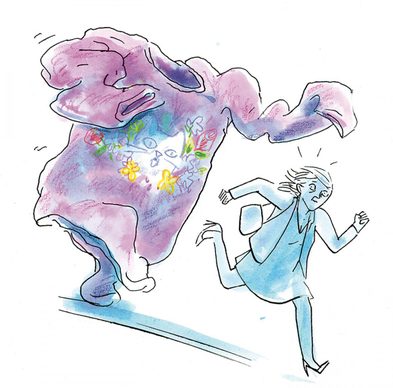
It’s not the first time I’ve been burned. Marketers hear “senior” and they default to dreary-one need only look to cruises aimed at the
60-plus crowd for further proof. Or to clothing catalogues. Who decided gear festooned with maple leaves and cats and polar bears was the thing? If I want to wear nature, it’ll be snakeskin on my handbags and mink on my collars. Neither of which go with a greyish-blue Senior Railcard.
Nowadays, our wallets bulge with plastic cards of various types and uses, all reflecting companies wanting to be branded as modern, vibrant and distinctive. We seniors also want to be recognized as modern, vibrant and distinctive. Our own individual brand is built around the fact that we love to laugh, we’re game for adventure, we eat out, volunteer, ski, see films, and shop for books, clothes and items for our smart digs. We grew up in the ’60s-is it so surprising we’d like a sprinkling of psychedelia on everything? In the ’80s we went to rock concerts; in the ’90s we took our kids to rock concerts. When the millennium hit, we adopted the latest technology without a second thought. Ditto for the latest nail-polish shade. But a greyish-blue travel card? Forget about it.
A lot of ink has been spilled in recent years bemoaning the sense of entitlement among boomers. To that I say, “So what?” We still want to live on the edge-if it comes with a state-of-the-art bathroom.
As for the train company, I’ll be writing a letter. It’s not always about the discount, after all; sometimes it’s about appealing to a client base that’s looking for a little Choo with its choo-choos.